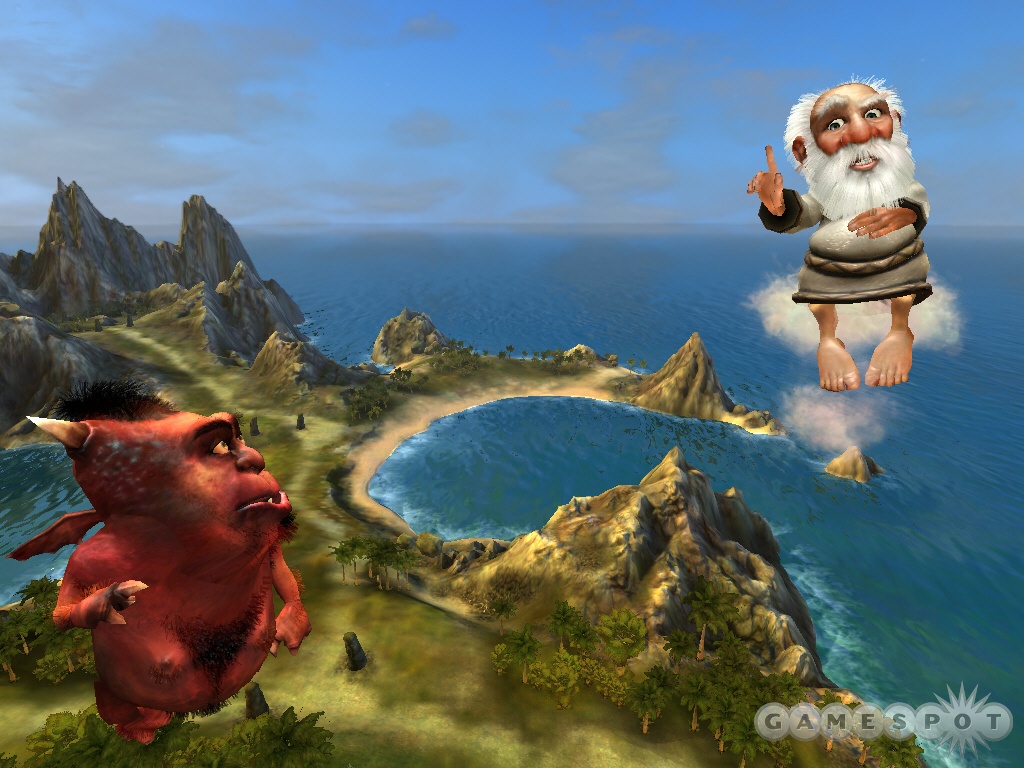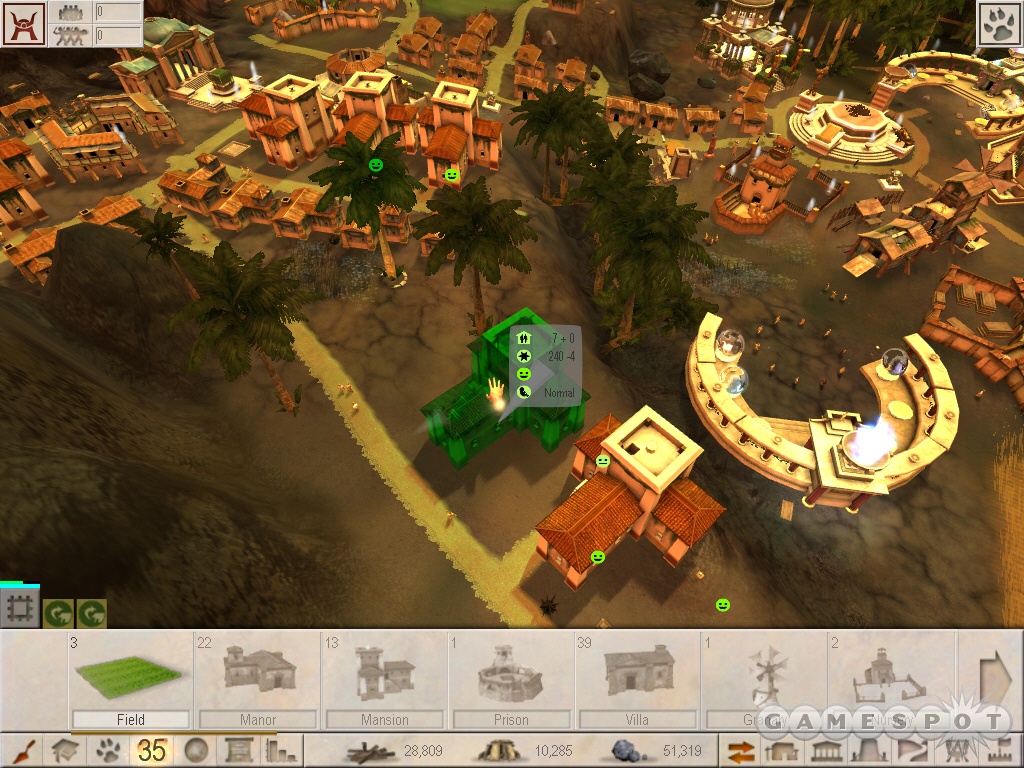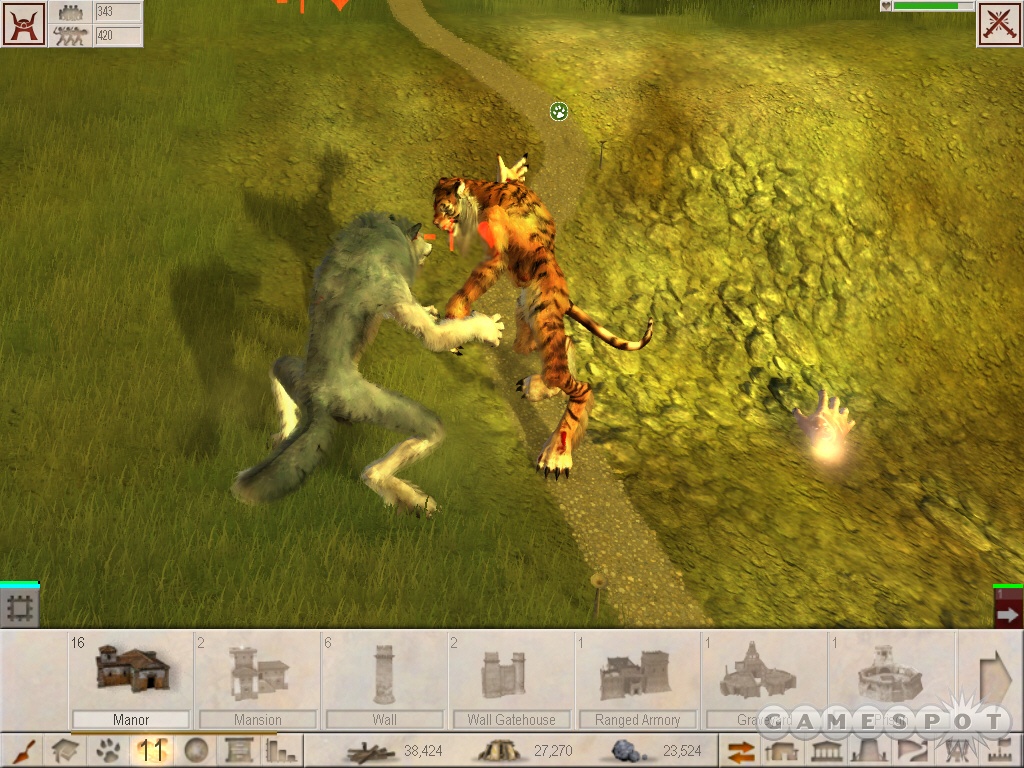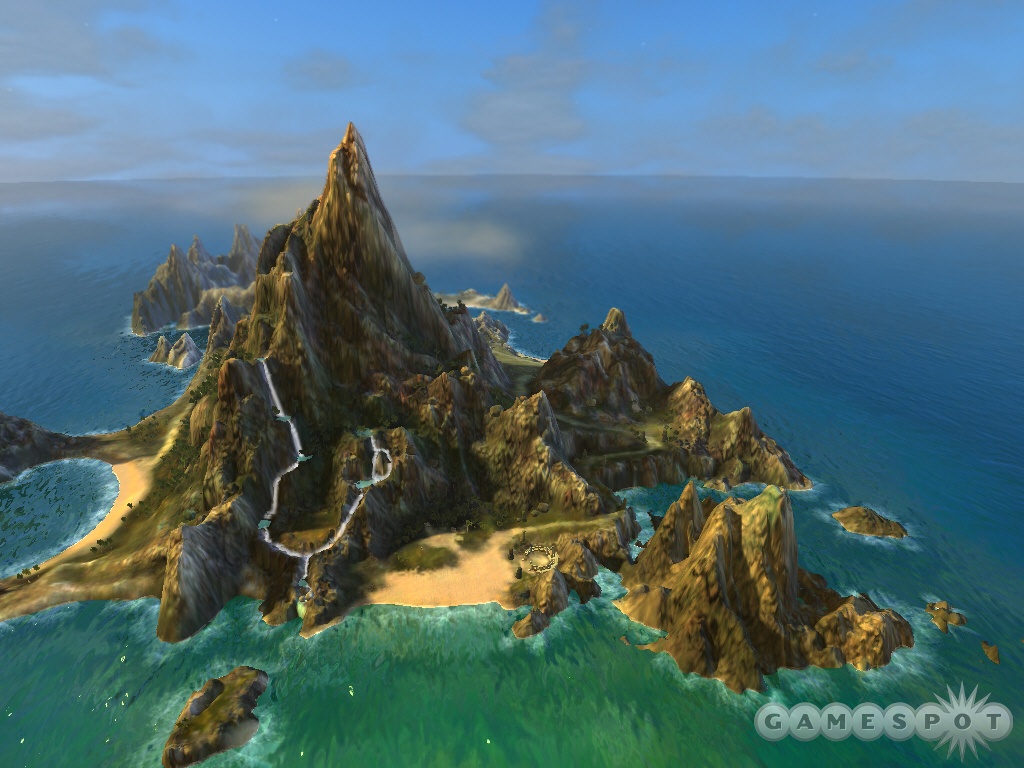The original Black & White was a strategy game that divided those who played it into two camps: those who loved its completely open-ended nature and those who felt that it was a bit too open-ended and meandering for its own good. For those waiting on Black & White 2, the good news is that the sequel is less open-ended and more structured. Indeed, this time there's a more coherent story, which makes it feel like a different game. However, this comes at the cost of some of the free-form gameplay that you may have loved from the original.

Like its predecessor, Black & White 2 combines distinctly different gaming genres into one game. You will construct sophisticated cities, raise armies and lead them into battle, and if that weren't enough, you get to interact with your giant creature, a sort of virtual pet that can also serve as your enforcer. There's so much in Black & White 2 that it's amazing it all blends together like it does. Though, it does go a bit overboard in some areas at times.
Black & White 2 is considered a god game because you play, well, a god. Specifically, you happen to be god for the Greeks, though that's not to say that you're a Zeus or a Hera or one from the traditional pantheon. The setting is in a fantasy world that happens to be occupied by the Greeks, the Norsemen, the Japanese, and the Aztecs. The Aztecs begin the game by sacking the Grecian capital, but not before you manage to spirit away a handful of survivors to a faraway land to begin anew. This story is a huge improvement over the first game, because it offers a cause to see to the end, as well as a focused enemy to take down.
As a god, you have a mutual relationship with your people. They worship you so that you can exist, and, in return, you provide for them and make sure that they flourish, which will increase your influence upon the world. That doesn't mean that you have to be a "nice" god, though, as the game takes its name from the fact that you can be a good and benevolent god, or an evil, bloodthirsty deity. For example, you require mana to fuel your godlike miracles, and this can be accumulated by getting your followers to worship you at an altar, or by picking up a random follower with your all-powerful hand and tossing him or her into the sacrificial fire. You can pick up and manipulate objects within your influence, and this also has a way of impressing the natives. If you need to construct a building quickly, you can tear out a tree and drop it onto the building's foundations. Or if you're a more patient god, simply pick up and drop a follower next to the thing you want done, and they'll get the hint.

With that said, it turns out that your primary job in Black & White 2 involves building cities. Indeed, the city-building constitutes a huge portion of the gameplay, and you can easily spend hours simply building up each city. There are two primary strategies, and both rely on building a formidable city. You can try to overwhelm your enemy peacefully by building a dazzling metropolis that causes his population to defect to your side, or you can create a huge city that supports a huge population, which supports a correspondingly large army, which you can then use to crush the other side. Or, as is often the case, you can use a blend of the two to achieve your means, conquering some cities peacefully, while conquering others through force.
The challenge with city design, of course, is that you're to build something complex in the space that you are given. Often, you have a limited amount of land to develop, as there are usually terrain features that prevent your city from expanding in certain directions. On top of that, you also must construct a city that you can defend, which means keeping the city inside defensible terrain, or constructing walls to keep invaders out. As with any city-building game, there are a large number of buildings and structures that you need to establish to support your population, like fields to generate food, homes, markets, and more. The choices you make have a cascading effect on the city. Put up a lot of hovels to house your expanding populace and you have an unhappy city. On the flip side, putting up mansions will be an inefficient use of what little space you do have. The idea is to balance your peoples' needs and to create something functional and pleasant (at least, if you're going for the peaceful victory). Meanwhile, if you're going for a militant victory, you still need to create an infrastructure to support large armies. This means fields to produce plenty of food, houses to support the workers, armories, and more.
The actual act of building cities is easy, thanks to the intuitive control scheme that lets you interact with the entire world with your all-powerful hand. The game tells you everything you need to know with helpful pop-up buttons, and you can satisfy the needs of your followers by just picking up what they want and placing it in the world. Need to build more houses? Simply grab an existing house, drag its outline to where you want to place a new one, and the foundations will be instantly laid for you. Or if you need to lay down a road, just grab an existing road and drag out the new road into the shape that you want. The entire control scheme is so elegantly thought-out that you hardly ever need to touch the keyboard.

While the city-building is at the heart of Black & White 2, it also feels like it drags on a tad too long. The first couple of cities that you build can be interesting, but by the latter part of the game, you realize that you're repeating the process over and over again. Most of what you're doing is waiting for structures to be built, or for your people to breed, or for a group of migrants to slowly make their way across the map to join your city. If you're trying for a peaceful victory, you're trying to shoehorn as many buildings as you can into your borders, a process that you've repeated in each prior level. This process can be prolonged, especially in levels where you're on the defensive the entire time. The enemy god can send an occasional natural disaster your way, which will force you to rebuild defenses, as well as anything else that was torn down. And while you can unlock a slew of new buildings over the course of the game, there's a certain point where you've unlocked pretty much everything and you're still building duplicates of what you've built before.
The other route to victory, war, isn't much quicker, though. You need time to build up the infrastructure and the platoons, as well as to whittle down the enemy's defenses. The battles in Black & White 2 can be epic in size, as you can hurl hundreds of soldiers into the fray. However, the tactics available to you are fairly basic and combat has a few quirks to it. Swordsmen slam together in a wild melee and run around hacking at each other. And occasionally platoons have the abilities to run through your walls, which can be galling when it happens. Unfortunately, the artificial intelligence is generally passive for most of the game, and it's content to send units at you piecemeal. In fact, it'll often camp units outside of your walls, within range of your archers, so that they can cut your archers down. This can be helpful to you, however, as victories grant your units experience to level up to become hardier and more powerful. Yet even with veteran units, you'll find that platoons pale in comparison to some of your godly abilities, such as the ability to hurl huge fireballs at them. And they're at a huge disadvantage to your creature.

The creature is your animal avatar in the game (you can choose from a cow, lion, ape, or wolf), and, like a pet, you "teach" it through reward (petting) and punishment (slapping). Since the creature is powered by a sophisticated AI, it slowly develops its own personality over time, and it can become almost obsessive-compulsive in its behavior. Not only that, but the creature "morphs" its appearance depending on its experience and environment. The more "evil" a creature behaves, the darker and more sinister its appearance, and vice versa. Or if your creature is a glutton, it'll become fat. Likewise, if it's a workout fiend, it'll become buff. The creature can be trained to become a lethal killing machine, or it can become a caretaker for your people, helping them gather crops, construct buildings, and entertain them. It can also be endowed with magical abilities of its own, such as the ability to cast lightning bolts, or to magically water fields, or heal wounded units.
Used properly, the creature can be your must powerful military unit. A well-trained creature can crush platoons of swordsmen, and it's fun to see it wipe out enemy units or knock down the walls of a city. About the only real threats to the creature are massed archers, as well as a rival creature. Creature-versus-creature face-offs can be both thrilling and frustrating, depending on which side of the beating your creature is on. (If your creature falls in battle, it'll "resurrect" itself automatically within a few minutes at your base.)
It's a lot easier to train the creature in Black & White 2, because now you can see what it is thinking. This allows you to preempt any bad habits that you don't want it to pick up. For example, a bored creature can get into all sorts of trouble, and sometimes its idea of "playing" with your people involves picking up heavy objects (its giant teddy bear) and throwing the objects at them. In Black & White, you had to see this behavior first before you could correct it, and you were never quite sure if the creature was learning the correct lesson. Now, you know what your creature plans to do, and you have immediate feedback as to whether it understands you. This gets at the heart of what makes Black & White 2 so different from its predecessor. One of the charms of the original was that you didn't know what your creature was thinking. It was fun to just watch the creature wander around and try to figure things out on its own, like a new puppy let loose in the house for the first time. It created all sorts of unexpected moments, like when the creature decided that it would rather eat your followers than pet them. Now that you can see your creature's thoughts, it feels like you're constantly rewarding and punishing it, rather than letting it grow and learn on its own. The emphasis in Black & White 2 is no longer on patience, but rather on getting results quickly. And while that will certainly appeal to gamers looking for more "structure," it'll likely disappoint those who admired the original game for its slower pace.

Aside from the city-building, real-time strategy, and creature-wrangling, Black & White 2 also presents some interesting puzzles that you can solve for tribute, which can be used to purchase new powers and abilities. Some puzzles simply present you with a mystery that you must solve, such as a strange sundial that requires you to manipulate the time of day in order to unlock its secrets. Other puzzles are presented as an opportunity for divine intervention. For example, you can "assist" a martial arts student in shattering stone plinths with his bare fist by punching the stone at the same time. In another, you need to deal with a monster that is living in one of your peoples' mines. These puzzles are an interesting diversion from the main game and can be quite challenging, as well as rewarding, when you finally figure them out. You almost wish there were more puzzles on each world, especially considering that the most powerful unlocks (the earthquake wonder, for example) require a vast amount of tribute.
The production components on Black & White 2 are generally outstanding, as you'd expect from a big-budget strategy game. Graphically, this is a rich game with an incredible sense of scale. You can zoom in close to the ground to see the individual blades of grass and insects crawling around, then pull the camera up to the stratosphere and look down on the land. The environments themselves are scenic and beautiful, and from afar they look like emerald jewels floating in sparkling blue oceans. Black & White 2 takes advantage of lots of fancy new graphical effects, such as depth of field, which blurs objects in the distance, as well as realistic (and fuzzy) fur on your creatures. Other than a few minor graphical artifacts, the game is pretty much blemish-free. Black & White 2 can also tax the latest hardware with all the graphical eye candy turned on and an army of hundreds battling onscreen. Thankfully, the game still looks good at lower detail levels, so you aren't losing much if you tone down the visuals. Meanwhile, the sound effects are like you'd expect, and there's some solid voice acting, particularly when it comes to your angel and devil advisers.

When you get down to it, how you felt about the original Black & White will determine how you feel about Black & White 2. If you felt like Black & White needed more structure and "gameplay" to it, then you'll likely appreciate the changes. However, if you enjoyed the freestyle nature of the original, you may be dismayed by some of the new features of the sequel. And if you've never played Black & White, you'll find an original and refreshing strategy game with excellent production values and a fairly unique style of gameplay. After all, how many city-building, real-time strategy, virtual pet games can you think of?